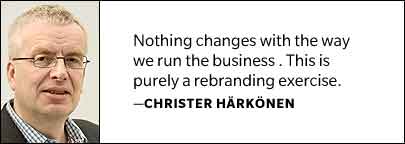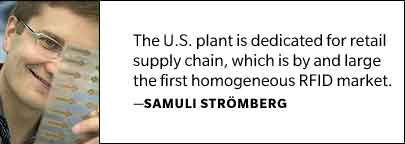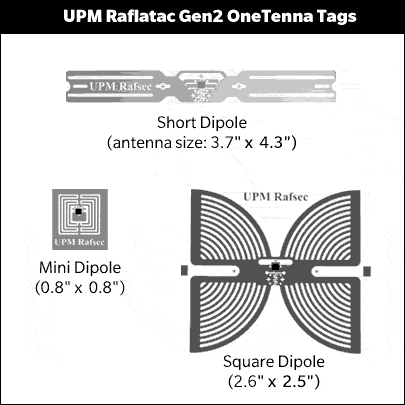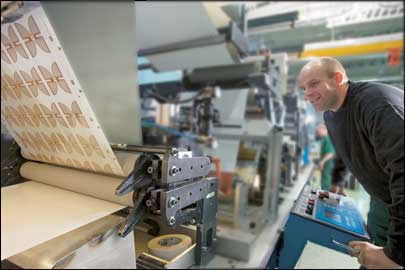Jan 30, 2006Since its creation in 1997, UPM-Kymmene's RFID inlay and tag division has had to take a flexible approach to the markets it targeted, the products it designed and manufactured and even its corporate structure. UPM-Kymmene, a Finnish company focused on producing a range of paper for such things as magazines, newspapers, envelopes, bags and packaging, launched its RFID division, Rafsec, as a way to extend its business into smart-paper products. Since then, control of the division has been exchanged between UPM-Kymmene and its label stock division, UPM Raflatac.
Rafsec was initially a subsidiary of Raflatac, spun off into a standalone subsidiary in 2000 and then turned into a new UPM division alongside Raflatac in early 2005. Now that it has been taken over by Raflatac, the Rafsec name will remain only in RFID products. Nonetheless, the RFID division says it will continue to operate unchanged within Raflatac and compete globally in an emerging mass RFID market, where its flexibility, combined with an ability to produce inlays and tags efficiently, will be essential to its success.
"There is a very strong commitment from UPM top management to grow the label stock business, which means that Raflatac is seen as a growth engine for the corporation, and there are very heavy expectations put on us," says Samuli Strömberg, vice president of marketing for Raflatac's RFID division. That gives Raflatac access to significant resources as it grows its RFID business.
The company's RFID division will continue to produce inlays and tags for both HF and UHF applications developed and sold by Rafsec in the past. HF tags are used in a range of applications, including library-book management, access control and mass-transportation ticketing; UHF applications, meanwhile, include supply chain management, baggage tracking and garment tagging. Before customers can use these inlays, however, they must first be converted into labels, either non-printable or printable. At its Finnish RFID plant, Raflatac produces both inlays to be converted into RFID labels by third parties, and finished tags made with its own label stock. According to the company, a majority of its U.S. sales are RFID inlays.
Raflatac has RFID manufacturing plants in both the United States and Finland, but it is its Finnish plant—located in the university town of Jyvaskyla, about 150 miles north from the company's Tampere headquarters—that produced Rafsec's first products. Operations here have also had to adapt to the changes in the RFID market (and UPM's strategy) since the plant first opened in 1999.
The facility covers 6,000 square meters and comprises five production lines for wide-web inlay manufacturing, where inlays are produced on a plastic film substrate preloaded with tag antennas. In the past two and a half years, Rafsec doubled its capacity and added four new production lines to the site to produce both UHF and HF tags.
The U.S. facility, in Fletcher, N.C., was built in 2005 and was up and running by October as part of a $24 million (€19 million) investment program. When fully implemented, it will give the plant an annual production capacity of 1 billion RFID tags. The U.S. plant was located close to the pressure-sensitive label stock production facility run by Raflatac, which supplied all the label stock used by Rafsec. The U.S. operation will be developed in stages to match production capacity with demand. So far, the first phase of the build-out gives the plant the capacity to make 250 million tags a year.
The two plants represent different approaches to the emerging RFID market. While the U.S. plant is configured to produce a limited number of inlay designs, all for the UHF market, the Finnish site has been configured with greater flexibility to meet the demands of the existing European market for HF RFID inlays, combined with the emergence of UHF RFID deployments. That flexibility was key during the first few years the Finnish plant was in operation.
"When production started in Jyvaskyla, there was no homogeneous RFID market," explains Strömberg. "At one time, we produced hundreds of products because all our customers wanted something different. We have been able to radically reduce the number of products down to around 50, with 20 percent of the designs making up around 80 percent of the volume."
The newly built U.S. plant, on the other hand, has been designed with a single technology (UHF) and low-cost production in mind. "The U.S. plant is dedicated for retail supply chain, which is by and large the first homogeneous RFID market. In the U.S., we were able to dedicate production to UHF products for higher production volume and efficiency," says Strömberg.
While the U.S. production plant manufactures its UHF inlays on a narrow web, the Finnish plant's five production lines use wide webs, adding flexibility to its production capabilities with the ability to create a wider range of inlay designs. While both narrow and wide web production lines can produce HF and UHF tags, Raflatac's RFID division maintains that extensive studies have shown that for its own products, narrow web can be used to produce UHF tags more economically than a wide-web process.
At present, the Jyvaskyla plant has the capacity to produce 250 million tags a year. Each of the site's five production lines is capable of producing either HF or UHF inlays, as well as a wide array of tag designs. However, with the new U.S. plant now in operation, the company is in the process of handing over production of UHF tags to the U.S. plant entirely.
According to UPM, it had been looking at the potential for setting up an operation in the United States, but quick growth in demand for UHF tags in this country made the plan a reality in 2005. "We had a master plan of adding U.S. production years ago, and it was just a matter of waiting for the right timing. When we saw the UHF market in the U.S. was growing fast, we made the final decision to go ahead and build the plant there," says Terävä.
While the major responsibility for delivering Raflatac's UHF inlays has been given to a new production plant, the Finnish operation has also recently handed over antenna production to Intune Circuits, formed jointly last May by UPM-Kymmene; Outokumpu Technology, a Finnish maker of stainless steel coils, wires, rods and bars; and Finnish Industry Investment Ltd., a government-owned venture capital company administered by the Finnish Ministry of Trade and Industry (see Intune Producing RFID Tag Antennas).
The rationale behind taking Rafsec out of antenna manufacturing was to increase the company's production flexibility and, potentially, save money. "When we made antennas ourselves, we invested in one production technology and we were tied to it," explains Härkönen, adding that Rafsec had not fully been able to utilize its own antenna manufacturing production capacity. "Now we have outsourced antenna production. If there is a better technology, we can use it."
Although Rafsec's antenna manufacturing machines in Jyvaskyla were sold to Intune, they have remained in the plant. Intune employees continue to operate the equipment at the Jyvaskyla site, while Intune prepares its own production facility outside Helsinki. The antenna maker says it plans to move the production line to its Helsinki facility by the middle of next year.
At present, Intune produces about two-thirds of the antennas used by Raflatac's Jyvaskyla production lines. In turn, Raflatac is currently Intune's only customer. The companies insist, however, they are not required to work with each other. "We handle Intune like any other supplier—they have to show they are comparable on price and quality," says Terävä. Rafsec, however, had always sourced its label stock solely from its former sibling company and now parent, Raflatac.
The most common inlays produced at the plant in Europe have a credit card-sized antenna and are used primarily for library book and media management systems and for closed-loop industrial applications tracking components in electronics manufacturing.
Most customer inlay orders require a four-week turnaround. "It's about three to four weeks from getting an order to shipping finished products," says Terävä. "We need to order antennas, calibrate the production line to antenna pad size [the area on the antenna that the chip is attached to], attach the ICs, laminate the inlays and carry out the final inspection."
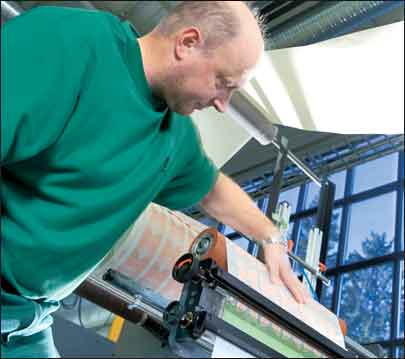
Raflatac produces inlays using both copper and aluminium antennas and utilizing integrated circuits from a number of semiconductor companies. The customer and the specific application normally determine which ICs come from which manufacturer. Raflatac's production lines attach the ICs, which arrive on 6- or 8-inch-diameter wafers, to the antennas mounted on a wide-web substrate spooled on reels. Sample inlays are tested on the production lines, and if the yield of functioning inlays is not high enough, the reel of antennas is removed from the machine and returned to the antenna manufacturer as faulty, so that additional ICs are not wasted on nonfunctioning inlays.
After the ICs and antennas have been joined, the resulting inlays are laminated with plastic or paper to seal and secure them. The laminated inlay is then printed with a die-cutting register mark (required by label converting machines, which use the mark as a guide for inlay placement).
Customers receive the reels of inlay tested, and any nonfunctioning tags removed, marked or replaced by operating tags. "Typical delivery format is one wide-web reel—typically between 3,000 to 10,000 pieces [inlays] per reel," says Terävä.
Raflatac's UHF inlays use its OneTenna UHF antenna. That, too, has been developed with flexibility in mind. Depending on the IC placement on the OneTenna short-dipole antenna, the company can manufacture the UHF RFID inlay to operate in the frequency ranges used in Europe (868-870 MHz), the United States (902-928 MHz) or Japan (950-956 MHz). Two additional IC placement positions on the antenna enable the finished inlay to operate while embedded in plastic, for either the European market or the U.S. one. Rafsec had also implemented its OneTenna design on other aluminum antenna models, as well as copper; however, not all of the Rafsec UHF tags and inlays use the OneTenna design.
Raflatac maintains that its OneTenna design helps lower the cost of producing RFID tags. In September, Rafsec priced its UHF Gen 1 and Gen 2 inlays at just under 10 U.S. cents apiece for a minimum purchase of 50,000 inlays. The company attributed the low cost to several factors: its OneTenna design, its inlay's high yield rate (on average, Raflatac claims, 98 percent of the inlays produced are fully operational) and the manufacturing flexibility of its recently opened production facility in Fletcher.
Moving under the control of Raflatac is just another change among many that the company has faced. "Rafsec has come full circle, but it was important—and a good business-building process—to be a standalone startup company for the first part of the decade, because the market required a new venture mentality," says Härkönen.
If the new Raflatac division is to achieve its goal of being a major producer of low-cost RFID inlays, its commitment to being nimble may yet prove invaluable. "We are very flexible. We also have a comprehensive product portfolio covering both UHF and HF, and we intend to keep our flexibility or agility as we continue to change and move forward," says Härkönen.

